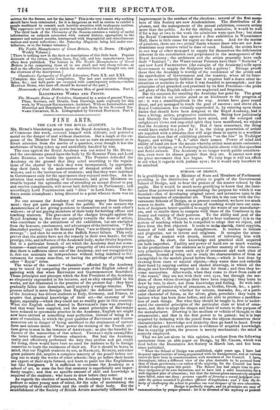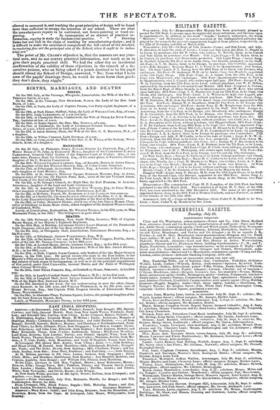SCHOOL OF DESIGN.
IT is gratifying to see a Minister of State and Members of Parliament presiding at the distribution of prizes to pupils of the Government School of Design, and to hear the praises of the master echoed by the pupils. But it would be much more gratifying to know that the insti- tution thus patronized was accomplishing the purpose for which it was founded—that of developing original talent and inventive taste in the various branches of ornamental art. That this is the case with the Go- vernment Schools of Design, as at present conducted, we have too much reason to doubt. A different system of teaching would turn out num- bers of designers better qualified to supply the wants of our manufactur-• ers, and to enable them to compete with those of the Continent in the beauty and variety of their patterns. To the ability and *zeal of the Director, Mr. C. H. WILSON, we are glad to bear testimony : it is to the system of teaching which he is compelled to adopt that we object, and have from the first objected. It tends to malw 'Levi* timid copyists, instead of bold and vigorous draughtsmen. It teaches to imitate and plagiarize, not to invent and originate. It occupies the atten- tion of the student with details, instead of informing him with principles. In short, the knowledge and practical skill acquired are both imperfect. Facility and power of hand are as much wanting in the productions of the students as is perfect mastery of the elemen- tary principles that govern each style of ornament and each class of patterns. Instead of being set to study the characteristics of form as exemplified in the models placed before them,—which is best done by drawing from casts or natural objects,—they waste time and enfeeble their hand by copying outline and shaded drawings, in which all the thought and knowledge required is done for them ; and thus they be- come mannerists. Afterwards, when they come to draw from casts or " the round," they see not with their own eyes, but through the me- dium of those whose drawings they have been copying : they learn to, draw by rote, in short, not from knowledge and feeling. So with imi- tating any particular style of ornament, as Gothic, Greek, &c., a parti- cular class of patterns, whether for cottons, damasks, &c., or a parti- cular character of forms, as for silver, glass, porcelain : they learn to imitate what has been done before, and are able to produce a modifica- tion of such things. But what they should bp-taught is; first {o" under- stand the essential principles of the particular clasi or kind of orna- ment, and then to adapt the shapes and hue's of nature to the purpose of the manufacturer. Drawing is the medium or vehicle of thought to the ornamentist ; and that is the first power to be gained: but it is best acquired by deducing with the pencil from the objects themselves their characteristics : knowledge and dexterity then go hand in hand. Every touch of the pencil in such practice is evidence of acquired knowledge. But in copying prints, the process is merely mechanical ; the mind is scarcely employed.
That we are not alone in this opinion, is evident from the following quotations from an able paper on Design, by Mr. CRABS, which was read before the Decorative Art Society in March last, and has been since published.
" Since the School of Design was established, eight years ago, I have had frequent opportunities of being acquainted with its management, and at various intervals have been in communication with members of the Council. I have, throughout, taken a different view of the plan desirable to be pursued from that of those gentlemen,—or rather of the majority, for the Council has been divided in opinion upon this point. The School has had ample time to pro- dace designers of its own formation, and to have laid a solid foundation for a well-digested plan of education; but that the various plans successively adopted have failed, none can deny : persons capable of forming a sound jud2n4ent con- sider the system unsuited to produce efficient draughtsmen; and I take the li- berty of challenging the school to produce one real designer of its own education. a • Design is perfectly simple, and its principles are easy of communication by proper persons : let it be divested of the mystery at present allowed to surround it, and teaching the great principles of design will be found more than sufficient to occupy the attention of our schooL Those are what the manufacturers require to be cultivated, not fresco-painting or wood-en- • • • In consequence of an absence of practical in- formation, n, copying is made the fundamental practice. * * • Drawing rip& forms but one link in the chain of teaching for manufacturing-design ; and it is difficult to make the uninitiated comprehend the full extent of the mischief, itr rendering fine art the principal aim of the School, when it ought to be indus- trial art."
The point of Mr. CRAM'S objection is, that the masters are not prac-
, tieal men, and do not convey practical information, nor teach so as to give their pupils practical skill. We had the other day an incidental confirmation of the validity of these objections in the remark of a de- corative painter, who on being asked if a youth destined to be his pupil should attend the School of Design, answered, " No; from what I have seen of the pupils' drawings there, he would do more harm than good: they don't draw, they niggle."



























 Previous page
Previous page